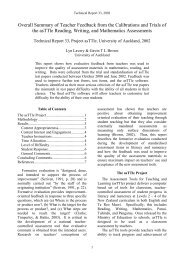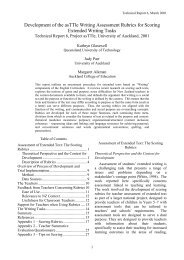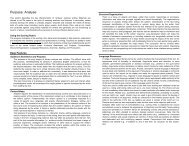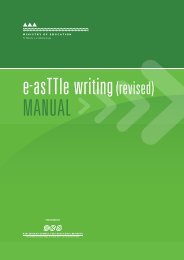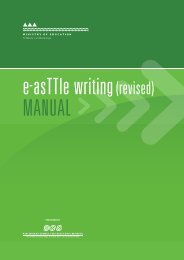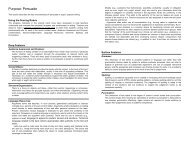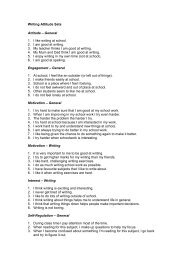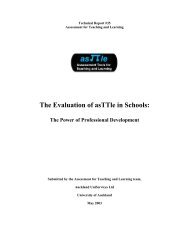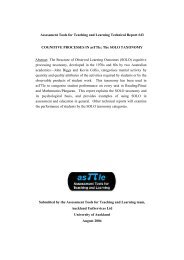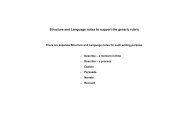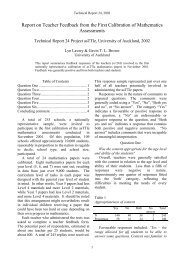11. Maths in the NZ curriculum 2001.pdf - e-asTTle - Te Kete Ipurangi
11. Maths in the NZ curriculum 2001.pdf - e-asTTle - Te Kete Ipurangi
11. Maths in the NZ curriculum 2001.pdf - e-asTTle - Te Kete Ipurangi
Create successful ePaper yourself
Turn your PDF publications into a flip-book with our unique Google optimized e-Paper software.
<strong>Te</strong>chnical Report 11: Mapp<strong>in</strong>g <strong>the</strong> Ma<strong>the</strong>matics Curriculum 5<br />
Objectives <strong>in</strong>volv<strong>in</strong>g symbols and equations<br />
from <strong>the</strong> algebra strand are also listed here,<br />
aga<strong>in</strong> emphasis<strong>in</strong>g <strong>the</strong> <strong>in</strong>terconnectedness<br />
between number and algebra at this level<br />
(English & Halford, 1995) and provid<strong>in</strong>g<br />
<strong>in</strong>formation about <strong>the</strong> symbols children might<br />
be us<strong>in</strong>g as <strong>the</strong>y solve problems, reflect<strong>in</strong>g <strong>the</strong><br />
second key <strong>the</strong>me of problem solv<strong>in</strong>g.<br />
Nickson (2000) noted that <strong>the</strong> “alternation of<br />
arithmetic-to-algebra and algebra-to-arithmetic<br />
pathways appears to be particularly important<br />
throughout this [early] phase of learn<strong>in</strong>g<br />
algebra. This helps to rem<strong>in</strong>d children of <strong>the</strong><br />
connections between <strong>the</strong> two, and <strong>the</strong> changes<br />
that are <strong>in</strong>volved from one to ano<strong>the</strong>r” (p. 145).<br />
Algebra objectives relat<strong>in</strong>g to <strong>the</strong> graph<strong>in</strong>g<br />
of relations are also <strong>in</strong>cluded here. Consider<strong>in</strong>g<br />
relations alongside arithmetic operations<br />
broadens children’s often narrow conception of<br />
operations as “two numbers equall<strong>in</strong>g<br />
someth<strong>in</strong>g”.<br />
Time<br />
Measurement objectives relat<strong>in</strong>g to time are<br />
clustered toge<strong>the</strong>r. They form a sub-strand of<br />
<strong>the</strong> measurement strand, and clearly stand apart<br />
from o<strong>the</strong>r areas of content. These objectives<br />
deal with tell<strong>in</strong>g <strong>the</strong> time, <strong>in</strong> units rang<strong>in</strong>g from<br />
a second to a year. <strong>Te</strong>ll<strong>in</strong>g <strong>the</strong> time is a dist<strong>in</strong>ct<br />
skill that can be separated from <strong>the</strong> o<strong>the</strong>r<br />
measurement objectives. Also, <strong>the</strong><br />
measurement of time is based on group<strong>in</strong>gs that<br />
differ from <strong>the</strong> base-10 group<strong>in</strong>gs used <strong>in</strong> o<strong>the</strong>r<br />
measurement tasks.<br />
Metric Measurement<br />
At Level 1, children are asked to order and<br />
compare, and to use non-standard units. The<br />
emphasis <strong>in</strong> Levels 2 to 4 is on develop<strong>in</strong>g <strong>the</strong><br />
ability to use metric measurement. The key<br />
<strong>the</strong>me at <strong>the</strong>se levels is that measurement<br />
should be taught through practical tasks<br />
requir<strong>in</strong>g <strong>the</strong> use of measur<strong>in</strong>g equipment.<br />
These objectives come from <strong>the</strong> estimat<strong>in</strong>g and<br />
measur<strong>in</strong>g sub-strand of <strong>the</strong> measurement<br />
strand <strong>in</strong> <strong>the</strong> Mi<strong>NZ</strong>C document. Both l<strong>in</strong>ear<br />
measurement and measurement <strong>in</strong> three<br />
dimensions are covered as <strong>the</strong> levels progress.<br />
<strong>Te</strong>mperature is also considered here. The<br />
Celsius scale is not a metric measurement, but<br />
rema<strong>in</strong>s with this cluster of objectives as it<br />
requires <strong>the</strong> mastery of read<strong>in</strong>g a scale with<br />
standardised units.<br />
Shape and Space<br />
This area has two key <strong>the</strong>mes – shape and<br />
position. Most of <strong>the</strong>se objectives appear <strong>in</strong> <strong>the</strong><br />
explor<strong>in</strong>g shape and space sub-strand of <strong>the</strong><br />
geometry strand <strong>in</strong> Mi<strong>NZ</strong>C, and clearly form a<br />
cluster of concepts. At Level 4, <strong>the</strong><br />
measurement objective relat<strong>in</strong>g to calculat<strong>in</strong>g<br />
area, perimeter, and volume has been <strong>in</strong>cluded<br />
under <strong>the</strong> shape <strong>the</strong>me. Measurement of area,<br />
perimeter, and volume provides a ma<strong>the</strong>matical<br />
way of describ<strong>in</strong>g a shape and its properties.<br />
Area and perimeter are often a “stick<strong>in</strong>g po<strong>in</strong>t”<br />
for learners. Understand<strong>in</strong>g <strong>the</strong>se concepts <strong>in</strong> a<br />
spatial way, and not simply as count<strong>in</strong>g tasks,<br />
may produce benefits for children (Nickson,<br />
2000).<br />
Transformation and Symmetry<br />
This area <strong>in</strong>cludes a clear cluster of<br />
objectives from <strong>the</strong> Mi<strong>NZ</strong>C document. They<br />
form <strong>the</strong> explor<strong>in</strong>g symmetry and<br />
transformation sub-strand of <strong>the</strong> geometry<br />
strand <strong>in</strong> <strong>the</strong> document. These objectives deal<br />
with rotation, reflection, translation,<br />
enlargement, and reduction, and with reflective<br />
and rotational symmetry.<br />
Probability<br />
Probability objectives are a sub-strand of <strong>the</strong><br />
statistics and probability strand of <strong>the</strong><br />
<strong>curriculum</strong>. They deal with understand<strong>in</strong>gs<br />
about choice and chance and how data of this<br />
sort can be generated and used predictively.<br />
They focus on <strong>the</strong> use of everyday language and<br />
experience at Level 2, and progress to more<br />
formal understand<strong>in</strong>gs and <strong>the</strong> use of<br />
appropriate equipment, such as sp<strong>in</strong>ners and<br />
dice, at Level 4. The probability objectives<br />
require children to th<strong>in</strong>k <strong>in</strong> a characteristic way<br />
about <strong>the</strong> world and <strong>the</strong> phenomena <strong>the</strong>y<br />
observe; thus, <strong>in</strong> this analysis <strong>the</strong>se objectives<br />
form a key <strong>the</strong>me that is dist<strong>in</strong>ct from <strong>the</strong> o<strong>the</strong>r<br />
statistics objectives.





